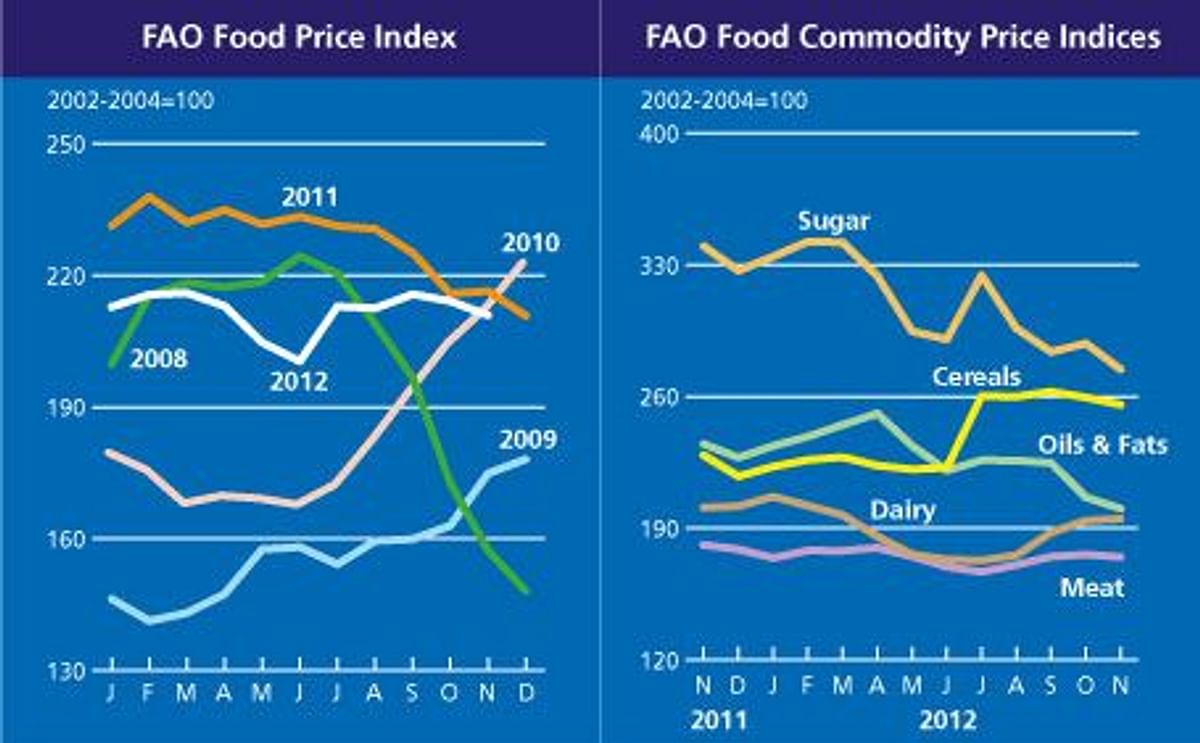The FAO Food Price Index averaged 211 points in November 2012, down 3 points (1.5 percent) from October and the lowest since June 2012. Except for dairy, international prices of all the commodity groups included in the Index fell in November, with sugar undergoing the sharpest dip, followed by oils and cereals. The decline puts the November index value nearly 3 percent below one year ago.
The FAO Cereal Price Index averaged 256 points in November, down 4 points (1.5 percent) from October but still 27 points (12 percent) higher than in November 2011. The decline was driven by a weakening of rice and wheat prices which more than offset the increase in maize quotations. Rice traded lower, mostly on abundant exportable supplies. Wheat values fell especially during the first half of the month as fears of an imminent export restriction by Ukraine receded. By contrast, maize markets received support on concerns over supply prospects and weather conditions in South America.
The FAO Oils/Fats Price Index averaged 200 points in November, down 6 points (2.9 percent) from October, and the third consecutive month of decline. The main driving factor remains abundant palm oil production, which, combined with weak world import demand, has led to further build-ups in inventories. Better than expected soy yields in the United States and large global availabilities of rape and sunflower-seed oils also weighed on the index, as did lingering concerns over poor economic growth world-wide.
The FAO Meat Price Index averaged 175 points in November, down only 1 point (0.7 percent) from the revised October value. Prices of all the meat categories remained close to last month’s level, except pigmeat, which subsided 4 points (2.2 percent). Compared to November 2011, meat prices stand 3.5 percent lower, with the weakening taking place in spite of a strong increase in feed prices, illustrating the extent the sector’s profit margins are being squeezed.
The FAO Dairy Price Index averaged 195 points in November, 1 point (0.5 percent) higher than in October. Prices appear to be stabilizing, after having risen from a mid-year low, when the Index stood at 173 points. The increases since August stemmed from supply uncertainty, combined with firm world demand. Currently, adequate availability, as a result of output growth in southern-hemisphere exporting countries, has caused prices to stabilize.
The FAO Sugar Price Index averaged 274 points in November, down 14 points (4.8 percent) from October, and 65 points (19.2 percent) lower than in November 2011. The decline in sugar quotations reflects prospects for large export availabilities in the 2012/13 marketing season, notably in Brazil, the world’s largest sugar exporter. However, the lower quotations provided an incentive to replenish inventories, which limited the extend of the decline in international prices.
Source: FAO
The FAO Food Price Index continued to trend downwards in November

¿Te gustaría recibir noticias como esta por correo electrónico? ¡Únete y suscríbete!
Get the latest potato industry news straight to your WhatsApp. Join the PotatoPro WhatsApp Community!
Empresa Destacada
Contenido Patrocinado
Contenido Patrocinado
Contenido Patrocinado
Contenido Patrocinado






